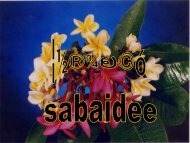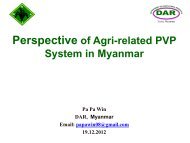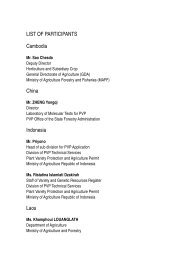Papaya (Carica papaya L.)
Papaya (Carica papaya L.)
Papaya (Carica papaya L.)
- No tags were found...
Create successful ePaper yourself
Turn your PDF publications into a flip-book with our unique Google optimized e-Paper software.
PROGRESS REPORTTHE HARMONIZATIONOF TEST GUIDELINE (TG)<strong>Papaya</strong>(<strong>Carica</strong> <strong>papaya</strong> L.)3 rd WORKSHOP FOR COOPERATION IN HARMONISATION OF TGs AND DUS TESTKuala Lumpur, August, 2 nd –6 th 2010
Team :1.Prof. Alejandro F.Barrientos2.Paerapong, Ph.D3.Pan Packao4.Danillo T.Dannug5.Dr. Abd.Rahman Milan6.Sunyoto7.Nani Suwarni8.Tsukasa Kawakami9.Machiko Naito10.Akio Kawase3 rd WORKSHOP FOR COOPERATION IN HARMONISATION OF TGs AND DUS TESTKuala Lumpur, August, 2 nd –6 th 2010
Conditions:• UPOV Draft for <strong>Papaya</strong> TG has Project 6• 42 characteristics in UPOV Draft Project 6• Focus on Hermaphrodite plants• Template the chapter 1 – 6 should besame as the UPOV format (standardwording)3 rd WORKSHOP FOR COOPERATION IN HARMONISATION OF TGs AND DUS TESTKuala Lumpur, August, 2 nd –6 th 2010
Discussion on Harmonized TG• P.1, 1.These TG apply to all varieties of <strong>Carica</strong> <strong>papaya</strong> L. ofthe family <strong>Carica</strong>ceae.• P.1, 2.3.The minimum quantity of plant material should be:200 seeds in the case of seed-propagated varieties,or6 hermaphrodite plants in the case of vegetativelypropagated varieties.• P.3, 4.2.2.Each test should be designed to result in a total of atleast 25 hermaphrodite plants or at least 6hermaphrodite plants or plant parts.3 rd WORKSHOP FOR COOPERATION IN HARMONISATION OF TGs AND DUS TESTKuala Lumpur, August, 2 nd –6 th 2010
• P.3, 4.2.3.For the assessment of uniformity apopulation standard of 1% and anacceptance probability of 95% should beapplied. In the case of a sample size of 6hermaphrodite plants, one off-type isallowed.3 rd WORKSHOP FOR COOPERATION IN HARMONISATION OF TGs AND DUS TESTKuala Lumpur, August, 2 nd –6 th 2010
• P.4, 5.3have been agreed as useful grouping characteristics: Plant : Multiple trunks (characteristic 4) Plant : height to first Inflorescence or flowerattachment (characteristic 2) Leaf blade : ratio length/width (characteristic 12) Leaf blade : number of lobes (characteristic 15) Petiole : anthocyanin coloration (characteristic 22) Fruit : ratio length/diameter at broadest part(characteristic 36) Fruit : shape (characteristic 37) Ripe fruit : Flesh color (Characteristic 44)3 rd WORKSHOP FOR COOPERATION IN HARMONISATION OF TGs AND DUS TESTKuala Lumpur, August, 2 nd –6 th 2010
• P.6, 7. Table of Characteristics3 rd WORKSHOP FOR COOPERATION IN HARMONISATION OF TGs AND DUS TESTKuala Lumpur, August, 2 nd –6 th 2010
Characteristics should be checked:1. Leaf blade: depth of lobe2. Petiole: attitude of attachment of petiole to mainstem3. Petiole: Color (Check for the yellow one)4. Inflorescence : anthocyanin coloration of axis(check if only in pedicel of flower)5. Flower: position of anther3 rd WORKSHOP FOR COOPERATION IN HARMONISATION OF TGs AND DUS TESTKuala Lumpur, August, 2 nd –6 th 2010
Characteristics should be checked:6. Fruit: Shape (check the reniform shape)7. Fruit: shape of stylar end8. Ripe fruit: flesh color (check the red one)9. Seed: color (check the grey yellow)10. Seed: sarcotesta appearance11. Seed: surface appearance3 rd WORKSHOP FOR COOPERATION IN HARMONISATION OF TGs AND DUS TESTKuala Lumpur, August, 2 nd –6 th 2010
P.13, 8. Explanations on the Tableof CharacteristicsAd. 1: Young plant: color of stemTo be observed when the first bud appears.Ad. 2: Plant: height of height to first Inflorescence orflower attachment3 rd WORKSHOP FOR COOPERATION IN HARMONISATION OF TGs AND DUS TESTKuala Lumpur, August, 2 nd –6 th 2010
Ad. 10,11,17,18: Leaf blade:widthlengthtertiary lobeprimary lobesecondary lobe3 rd WORKSHOP FOR COOPERATION IN HARMONISATION OF TGs AND DUS TESTKuala Lumpur, August, 2 nd –6 th 2010
Ad.37: Fruit: shape3 rd WORKSHOP FOR COOPERATION IN HARMONISATION OF TGs AND DUS TESTKuala Lumpur, August, 2 nd –6 th 2010
Ad. 38: Fruit: shape of stalk end1 2 3 4pointed rounded truncate depressed3 rd WORKSHOP FOR COOPERATION IN HARMONISATION OF TGs AND DUS TESTKuala Lumpur, August, 2 nd –6 th 2010
Ad. 42: Fruit: ridgesTo be observed in transverse section.1 2 3 4absent or weak moderate strongvery weak3 rd WORKSHOP FOR COOPERATION IN HARMONISATION OF TGs AND DUS TESTKuala Lumpur, August, 2 nd –6 th 2010
Conclusion:• Some characteristics should be checked(if it’s suitable for DUS test and there isexample variety could be put in the TG)• Add some explanations for necessarycharacteristics• Add state of expression which othercountries have an example variety3 rd WORKSHOP FOR COOPERATION IN HARMONISATION OF TGs AND DUS TESTKuala Lumpur, August, 2 nd –6 th 2010
3 rd WORKSHOP FOR COOPERATION IN HARMONISATION OF TGs AND DUS TESTKuala Lumpur, August, 2 nd –6 th 2010
















